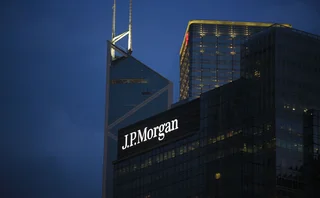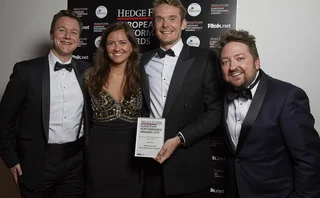
White-lightning response is needed for US market
There is still fundamental value in the US market, but fund managers have to be quick of the mark to exploit the current situation
Hedge fund managers agree the US market favours stockpickers but some are predicting many years of trendless sideways movement and sharp bear rallies that only the most nimble manager will be able to exploit.
Julian Wheeler, principal manager of Gulf International Bank's Falcon US Long/Short Equity Fund, says the current US market still offers fundamental value despite S&P 500's price/earnings ratio of 30.3 still being above its long-term average.
The fund has a slight bias towards long positions (34% in 11 positions) over short (29.6% in 10 positions), with the remaining 36% held in cash.
'We believe money should only be invested where you think you have got a better chance of making a profit through investment,' says Wheeler.
The 'sharp bear rallies' the US has experienced recently have made things difficult for fund managers, he adds. 'We have had a generally short view, but you have to take some evasive action when the rallies take place.'
The Falcon fund made some profits going long on gold stocks, as well as on the $525m US retailer, Stage Stores.
Wheeler says it is often the under-appreciated mid-cap stocks whose price can climb but allow fund managers to buy in before the broader market recognises their potential.
'On the short side, the profitable firms for us would include the telecoms and cable sectors ' and I would include AOL Time Warner in that. We closed that position (recently) when the downgrades by Wall Street may have drawn a line under the share price fall.'
He says a short US rally could come, based on sentiment indicators, high cash holdings, the end of the current reporting season and the 14 August deadline for the US's top 1,000 firms to sign off confirmed accounts.
'If all this goes smoothly, you could expect to see some rally. We are positioned slightly long for this reason, but, overall, we do not believe the macro climate will allow for an over-optimistic outlook for earnings. You have some analysts saying that with these interest rates and low inflation, that justifies a higher P/E, but in a low interest rate and low growth environment that is exactly what you have ' low growth.'
Gulf International Bank plans to market the $25m fund more openly toward the end of 2002 when Wheeler has a 12-month track record on the fund.
David Webb, portfolio manager of the closed $567m US long/short Shaker Heights Investment Fund at Ohio's Shaker Investments, says the investment-led expansion unwinding in the US is comparable in history only to the US in the 1930s and Japan in the 1980s.
'In these periods consumption lags both on the way up and the way down. In Japan, consumption accelerated in the first two years after the market peak from extra stimulus applied by the government,' says Webb.
'In the US, the whole private sector is in variable rate debt, which with low interest rates is manageable, but when you get a whiff of inflation you get many years of difficulty. Just because we're nearing the end of the first phase of recovery, it would be a huge mistake to think there is less risk of loss.
'You may think the downward swing has been going on for two years, but the problem is that the last legs downwards are some of the worst in terms of percentage decline.' Webb says the second phase can involve more than a year of 'meandering markets' with short rallies, and Shaker's US long short aims to sell into periods of optimism. He spreads the fund's long-side over more than 100 positions. On the short-side he tries to construct, and then invest in what he calls 'the world's crappiest index' ' the firms least expected to do well.
Webb uses the simple metric of directors trading their own shares to indicate a possible market inflexion point. 'But the trend here is still shockingly negative,' he says. 'If people are selling, particularly after something is down, that is a bad sign and chances are the stock can drop another 10% from that level. Managers had ample opportunity to buy after the last move up after 11 September, a move courtesy of the Fed, but they are still selling.'
Only users who have a paid subscription or are part of a corporate subscription are able to print or copy content.
To access these options, along with all other subscription benefits, please contact info@risk.net or view our subscription options here: http://subscriptions.risk.net/subscribe
You are currently unable to print this content. Please contact info@risk.net to find out more.
You are currently unable to copy this content. Please contact info@risk.net to find out more.
Copyright Infopro Digital Limited. All rights reserved.
As outlined in our terms and conditions, https://www.infopro-digital.com/terms-and-conditions/subscriptions/ (point 2.4), printing is limited to a single copy.
If you would like to purchase additional rights please email info@risk.net
Copyright Infopro Digital Limited. All rights reserved.
You may share this content using our article tools. As outlined in our terms and conditions, https://www.infopro-digital.com/terms-and-conditions/subscriptions/ (clause 2.4), an Authorised User may only make one copy of the materials for their own personal use. You must also comply with the restrictions in clause 2.5.
If you would like to purchase additional rights please email info@risk.net
More on Hedge funds
JP Morgan warns hedge funds to expect intraday margin calls
US bank may demand variation margin ‘up to seven’ times a day after Archegos default
Alternative markets give edge to Florin Court strategy
By concentrating on exotic and alternative markets, Florin Court Capital Fund has sidestepped overcrowding and correlation to the main trend following commodity trading advisers, offering investors a diversified alternative to the standard systemic macro…
Global macro views combine with quantitative models to produce consistent returns
The team behind River and Mercantile Group’s global macro strategy team operates under two key principles: that macro is the most important aspect of any investment decision and that decision-making should incorporate both systematic and discretionary…
On the offensive – Seeking a new edge, buy-side invests in portfolio and risk analytics
A fast-moving, headstrong hedge fund – hit by rare losses after a black swan event touched on an overweight country exposure – ponders adding fresh quantitative expertise. Much to traders’ chagrin, the chief investment officer and chief operating officer…
Esma backtracks on account segregation
Status quo protected for rehypothecation of collateral in tri-party, securities lending and prime brokerage
Redemptions focused within strategies suffering losses in 2016
Redemptions focused within strategies suffering losses in 2016
Hedge fund redemptions a dismal end to a bad year
Managed futures funds saw big inflows in 2016, but left investors disappointed
Larger funds are net losers as outflows continue
Managed futures funds have seen biggest redemptions for three years






